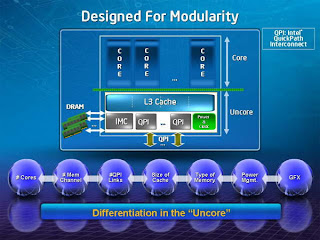
In the ever-revolutionizing world of processors, one name always comes to mind: Intel. The other key player is AMD. Currently, the latest offerings from AMD are competing with Intel’s Core 2 architecture based processors. Intel, after the massive success of Core 2, went ahead and has introduced Core i7 architecture. Currently king of the ring, the Core i7 has the most sophisticated and extremely powerful processors for Home and Business users.
Within the Core i7 series are four variables to choose from: Core i7-920, Core i7-940, Core i7-965 Extreme Edition, and last but far from least: Core i7-975 Extreme Edition. The clock speeds starts at 2.66GHz and all the way up to 3.3GHz. The Core i7-975, which we are looking at today, has its clock stabled at 3.33GHz and with Intel Turbo Boost, clock speeds at 3.45GHz (all cores) and 3.6GHz (single core).
Below are the five different Core i7 processors currently available. Please note that the entry-level Core i7-920 is alone very capable of outperforming the mammoth Core 2 QX9770!
| Core i7 975 XE | Core i7 965 XE | Core i7 950 | Core i7 940 | Core i7 920 | |
| Clock frequency | 3.33 GHz | 3.20 GHz | 3.06 GHz | 2.93 GHz | 2.67GHz |
| Quick path speed | 6400 MT/s | 6400 MT/s | 4800 MT/s | 4800 MT/s | 4800 MT/s |
| Memory controller | DDR3-1333 | DDR3-1333 | DDR3-1066 | DDR3-1066 | DDR3-1066 |
| Price | $999 | $899 | $599 | $562 | $284 |
| Parallelism | 4 Physical Cores, 8 Logical Processors (Hyper Threaded) | ||||
| Memory standard | Triple Channel DDR3 | ||||
| L2 Cache size | 256 KB per core | ||||
| L3 Cache size | 8 MB | ||||
| Transistor count | 731 Million | ||||
| TDP | 130 W | ||||
| Fabrication process | 45 nm | ||||
The Core i7 Extreme 975 runs at 3.33GHz, which is a 133MHz faster than its 965 Extreme. Apart from the 133MHz increment, the Core i7-975 offers the D0 stepping in response to Core i7-965 C0. The Core i7-975 offers lower power consumption and provides greater overclocking headroom. The quad-core Bloomfield processor, Core i7-975, uses 1 MB of L2 cache and 8 MB of L3 shared cache memory. The TDP for this processor is be 130W (TDP = maximum peak wattage).


Architecture of Core i7: Nehalem
The new Intel Core i7 (Bloomfield) processors have the following deeper features:
- Four processing cores
- Support for SMT (simultaneous multi-threading), allowing up to 8 threads to be processed simultaneously
- 32 KB instruction + 32 KB data L1 cache per core
- 256 KB L2 cache per core
- Large 8 MB L3 cache shared by all 4 cores
- An integrated memory controller (IMC) supporting three channels of DDR3 memory
- Memory clock speeds of up to 1333 MHz
- Memory bandwidth of up to 32 GB/s
- Up to six memory sockets
- The new Intel Quick Path Interconnect (QPI) replaces the front side bus (FSB)
- Addition of seven new SSE4 instructions
- Monolithic processor design (all four cores on a single die)
- Fabricated using Intel’s 45nm high-k process technology

Like the Core 2, the Core i7 has the 45nm fabrication. The Core i7 has a 731 million transistors count. Nehalem processors will default at 64KB of L1 cache and 256KB of L2 cache. L3 cache of 8MB for quad-cores is shared among the four cores.
Some of the key micro architecture design features.














No comments:
Post a Comment